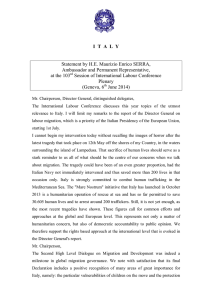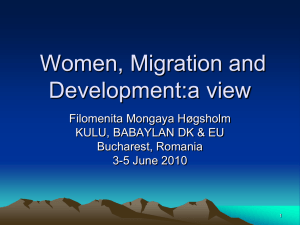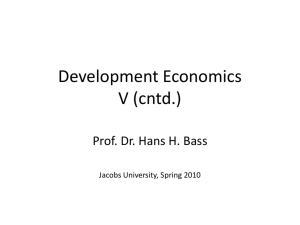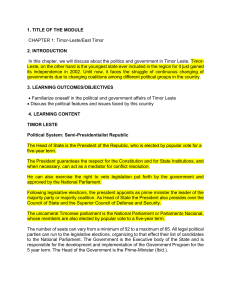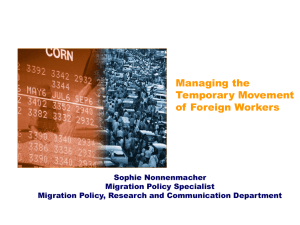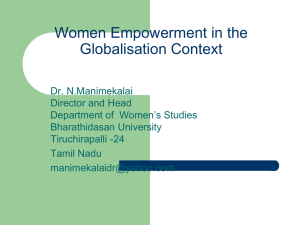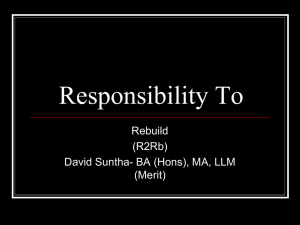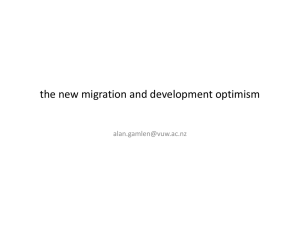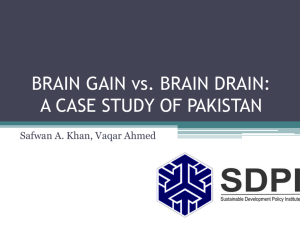Rural- Urban Inequalities and Migration in Timor-Leste
advertisement
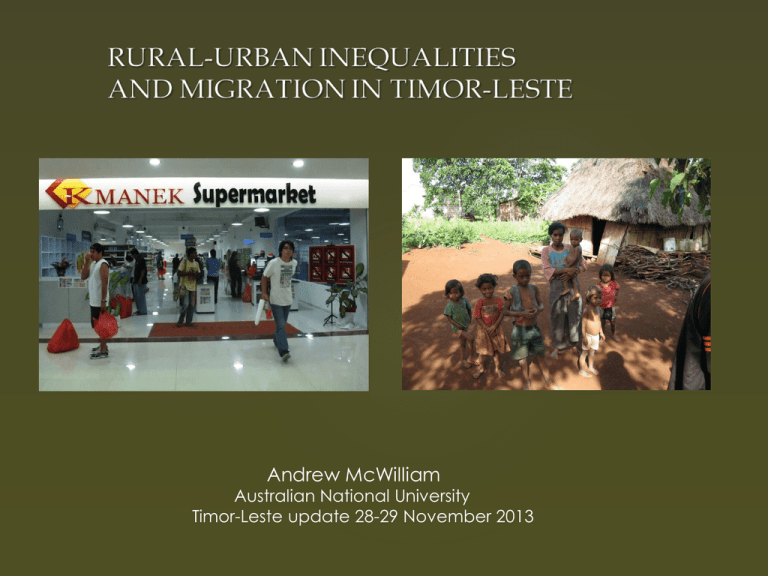
Andrew McWilliam Australian National University Timor-Leste update 28-29 November 2013 Demographic Snapshot of Inequalities. Population: 1,154,625 (2012) Population Urban = 29.6%, Rural = 70.4% Poverty - 50% less than $2/day – High levels of vulnerability in rural areas. Safe Drinking Water: Urban = 91% Rural = 57% High child mortality 136/1000 by 5 years Children in urban areas are almost four times more likely to be enrolled at secondary school than their peers in rural areas. Material Benefits over the last few years 1. Expansion of new schools and health clinics – much greater access 2. Social payments from the state – Pensioners, Veterans, village subsidies 3. Electricity rollout to much of the rural hinterland. 4. Expansion of Mobile telephony – much improved communications 5. Gradual improvements in road infrastructure and agricultural production. MIGRATION – A RESPONSE TO INEQUALITY Key drivers • Poor economic prospects in home communities – few employment choices • Young people more educated, resistant to taking up semi-subsistence farming and the confines of aldeia sociality. • Youthful desire to engage and consume modernity – bright lights and buzz of the city. Post 1999 and continuing • Mobility, migration and urban drift – esp. among young people. [from village to district towns, and towns to the city] • Dili population increased by 33 per cent or 58,296 residents [ represents 40.7% of increased population since 2004] • Youthful aspirations are constrained by high youth unemployment and strong competition for limited jobs. • High levels of disaffection – boredom – gang behaviour – with unemployment and underemployment a key challenge for the future. Trans-national Migration: one response • Since 2000 a sustained international labour migration of young East Timorese to the United Kingdom seeking low skilled and shift work opportunities – thousands involved. • Origins of migration in Student Activism and resistance 1990s –Political Asylum [Suaka politiku] 1993-4 led to a core group of activists in Portugal and UK. 2 Key enabling Elements • • Post 1999: East Timorese recognised as Portuguese citizens - eligible for passports and access to EU employment. Sponsorship in Portugal important to facilitate bureaucratic processing of passport requirements and help fund costs. • Pathways to work through chain migration of kin (siblings/cousins) 800 young Timorese leaving for overseas work per annum (Shuaib 2008). • 2002-2008 boom times – now slowed due to GFC but large numbers still aspire to make the journey and secure work in UK. Migration Experiences Shared living/ access community services/ limited outside mixing/ poor English/ Low wage, shift work as source of capital, generating savings from meagre wages. • [ Renaldo: Oxford 2002-2007, worked as cleaner, night porter and as shelf stacker at Tesco’s, ₤800/m, saving ₤400/m to send to wife and children for living expenses and to build a house] Dungannon & Portadown (Nth Ireland/Belfast) • popular – low English requirements • During boom times >1000 young Timorese (Male & Female) took up meat packing work. [Moy Park Chicken – UK market & Euro exports] • Since 2008 dispersal of migrants to other cities for work and shifting employment – Crewe, Peterborough, Bristol, Gloucester… Social and Economic Dynamics of Remittance landscapes Western Union (2008) remitting some $370,000 per month into Timor Leste. Predominantly from UK (Shuaib 2008). Remittances as monetarised expressions of care and obligations to family (McKay 2007). 1. Regular financial support for parents, siblings , spouses and children • Consumables / daily needs • Contributions to family life cycle events – marriage / funerals 2 Savings to build or renovate housing 3 Financial stake for economic enterprise Kios/ trading capital /micro-enterprise 4 Funding for further training in higher education and to support education of siblings Ira Ara, Old and New: 2013 Building boom, 95% funded from UK work New housing as an index of migration success. [$5000 = rendered cinder block house & metal roof and tiled floor after one year in the UK ] Negatives impacts Long absences strongly felt. Lack of young people to provide social labour for ceremonies and farming. Social jealousies and resentments Weakening of cultural bonds – few people return to settle for good. Sense that UK work does not build career skills Changing Livelihoods and opportunities • Shuaib (2008) – ‘Households with members working • UK employment contributes up to $8million per annum to Timor Leste economy – with large local benefits • Value of inward remittances to Timor Leste makes labour the country’s second largest export after coffee • Government supported scheme: South Korea 2000, Malaysia and Indonesia. Seasonal Workers Program in Australia - horticulture and hospitality – 50 participants but unattractive costs for employers. • Role for greater government policy support for labour migration and remittances overseas and sending remittances are better off financially by many multiples than households pursuing local employment’ Conclusion • International migration (for labour and education) has become a livelihood choice– given continuing poor employment prospects in Timor Leste – a growing trend • Near neighbour Australia has a long term demand for labour and the capacity to provide training in occupational skills. Timor-Leste has a growing generation of young people seeking employment opportunities--- an opportunity waiting to be fulfilled.

